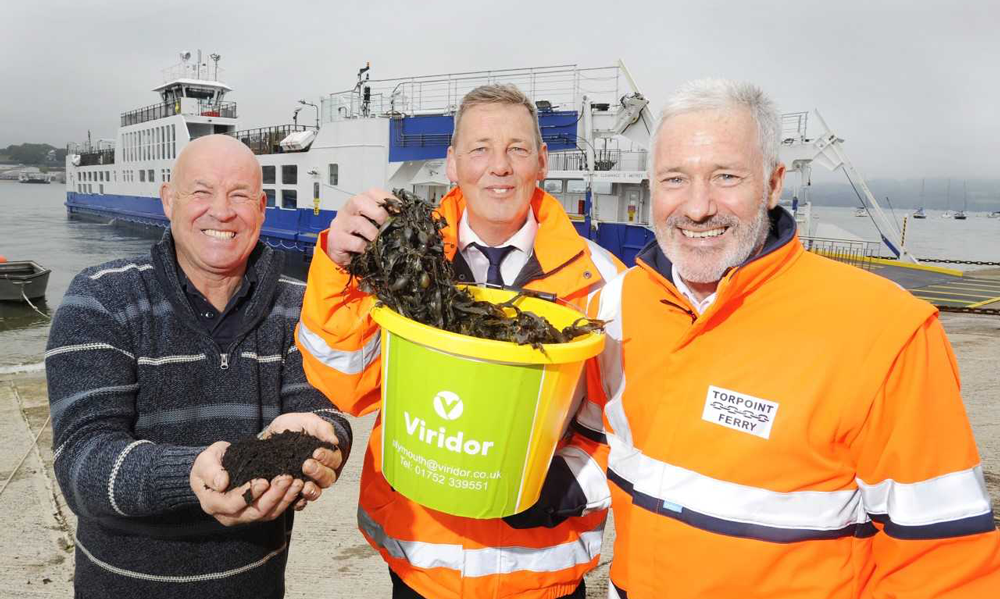Viridor has taken 65 tonnes of seaweed – enough to fill five double-decker buses – washed up on the two slipways operated by the Torpoint ferry over the course of a year so that this can be processed as part of a collaborative new scheme.
The value of this nutrient-rich seaweed is retained as an agricultural fertiliser thanks to a partnership involving Viridor, Bragg Contracting, and Tamar Crossings.
The Torpoint Ferry, jointly owned by Cornwall Council and Plymouth City Council, is the world’s biggest and busiest chain ferry service and the UK’s busiest inland waterway ferry crossing – providing crossings for up to 8,000 vehicles and 1,500 pedestrians each day.
Seaweed, algae and other materials are washed up onto the slipways at either side of the River Tamar crossing with every tide. This debris must be regularly cleaned off to avoid creating a potentially slippery surface for people using the crossing. Tamar Crossings use a specialist company to carry out this work, with cleaning taking place twice a week during the autumn and winter months, increasing to three times a week during the spring and summer.
The seaweed project is part of the ‘zero to landfill’ waste collection and recycling contract for non-hazardous waste awarded to Viridor by the Tamar Bridge and Torpoint Ferry Joint Committee in December 2017.
“Viridor is focused on giving all waste a new purpose so it is not considered rubbish and so it is gratifying to be part of a project that produces such useful product, a really good fertiliser to feed the crops and enhance food production, allowing us to plough the seaweed we have collected back into the earth.”
 Lee Gomersall, Key Account Manager at Viridor, said: “The seaweed must be collected and removed. It cannot be returned to the sea because it may have picked up contamination, including additional waste materials, such as plastics, but we all recognise the important properties seaweed offers and it was vital to find a way to retain this and put it to good use.
Lee Gomersall, Key Account Manager at Viridor, said: “The seaweed must be collected and removed. It cannot be returned to the sea because it may have picked up contamination, including additional waste materials, such as plastics, but we all recognise the important properties seaweed offers and it was vital to find a way to retain this and put it to good use.
“Viridor is focused on giving all waste a new purpose so it is not considered rubbish and so it is gratifying to be part of a project that produces such useful product, a really good fertiliser to feed the crops and enhance food production, allowing us to plough the seaweed we have collected back into the earth.”
David List, General Manager of Tamar Crossings, welcomed the seaweed recycling project. “Removing the seaweed from the surface of the two slipways is part of our regular maintenance routine and it is good to see it now being recycled as a fertiliser,“ he said.
Dave Bragg, from Bragg Contracting, is the dairy, beef and arable farmer who takes the seaweed to his 750-acre Tavistock farm and reprocesses it to create a high-quality fertiliser.
Dave said the reprocessing procedure involves hand and mechanical sorting to remove any contamination before mixing the seaweed with green waste from Plymouth and West Devon councils. He then puts the material through a shredder, turning and screening the mix over a two-week period and monitoring the temperature to ensure it reaches above the 65C required to achieve sanitisation. A further 10 weeks of monitoring and turning is then needed for stabilisation before the product is ready to use. A 40mm fertiliser is produced for arable farming and 20mm for grassland.
Dave, who uses the fertiliser on his own arable farmland and distributes within a 5km radius of Tavistock, said: “It’s such a rich fertiliser, you can immediately spot the difference, I think. My fields are glowing green and you can see the difference from the worm activity. Last year, when other maize crops were struggling in dry conditions, mine was 11 foot and people said it was the best maize they’d ever seen.”
Viridor Development Manager Marcus Du Pree Thomas said: “Seaweed makes such an excellent fertiliser because it supplies a readily available balance of key nutrients and a full range of trace elements to support sustainable, healthy plant growth, plus, in terms of soil structure, its jelly-like alginate helps to bind soil crumbs together reducing weather-related erosion.”

